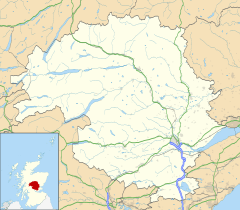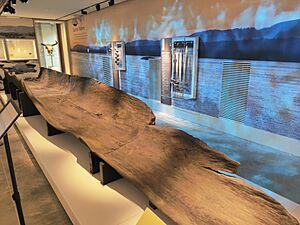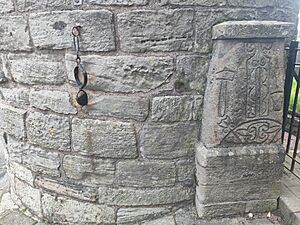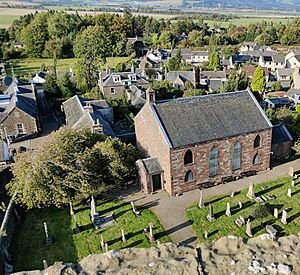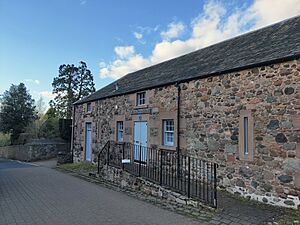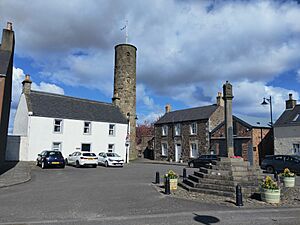Abernethy, Perth and Kinross facts for kids
Quick facts for kids Abernethy
|
|
|---|---|
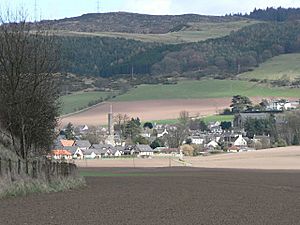 The village of Abernethy viewed from the north |
|
| Population | Expression error: "Lua error in Module:Tabular_data at line 91: attempt to index field 'data' (a nil value)." must be numeric (2020) |
| OS grid reference | NO189163 |
| • Edinburgh | 27 mi (43 km) |
| • London | 358 mi (576 km) |
| Council area | |
| Lieutenancy area | |
| Country | Scotland |
| Sovereign state | United Kingdom |
| Post town | PERTH |
| Postcode district | PH2 9xx |
| Dialling code | 01738 85 |
| Police | Tayside |
| Fire | Tayside |
| Ambulance | Scottish |
| EU Parliament | Scotland |
| UK Parliament |
|
| Scottish Parliament |
|
Abernethy is a village in Scotland. It is located in the Perth and Kinross area. This village is about 8 miles south-east of the city of Perth. It sits near where the River Earn meets the River Tay. Abernethy is also on the edge of the Ochil Hills.
Long ago, Romans had camps here. Later, Abernethy became a very important place for the Picts. It was a center for their religion and government. A famous event called the Treaty of Abernethy happened here. In this treaty, Malcolm Canmore, a Scottish king, showed loyalty to William the Conqueror. The village also has an old round tower. This tower shows where an old church, called an abbey, used to be.
The area around Abernethy also includes a nearby village called Aberargie. It even stretches to Mugdrum Island in the Firth of Tay.
Contents
Abernethy's Past
What's in a Name?
The name Abernethy was first written down in the 900s. It means 'mouth of the river Nethy'. The word aber comes from the Pictish language. It means 'river mouth'. The name Nethy comes from an old Celtic word. It means 'pure' or 'clean'. The Nethy Burn is a small stream that flows from the Ochil Hills past the village.
There is also a small place nearby called Catochil. Its name might also come from the Pictish language. It could mean 'woodland' and 'high'.
Ancient Times
People have lived in the Abernethy area for a very long time. In 2001, an old Bronze Age log boat was found at Carpow. It is thought to be from around 1,000 BC. This boat is one of the best preserved in Britain. It is also the second oldest boat found in Scotland.
Old stone circles have been found near the village. These circles were likely built by people long ago. Castle Law was once an Iron Age hillfort. This fort was first explored in the late 1800s.
Several Roman sites are in the village area. These include the fort at Castle Law. There was also a Carpow Roman Fort to the east of the village.
The Middle Ages
Abernethy was once a very important place for the kingdom of the Picts. It was a major religious and political center. The local church is named after Brigid of Kildare, a saint from Ireland. It is believed that this church was started by Dairlugdach. She was a leader from a big early Christian monastery in Ireland.
Several old Pictish sculptures have been found in Abernethy. One Pictish stone is attached to the base of the round tower. Abernethy is also thought to be the "Afarnach's Hall" mentioned in early stories about King Arthur.
Abernethy was once the home of an early Pictish bishop. A bishop is a high-ranking church leader. In the 1100s, the bishop's home moved away. Today, Abernethy is listed as a "titular see" by the Catholic Church. This means it was once a bishop's seat but no longer is.
In 1072, the Treaty of Abernethy was signed here. This was an agreement between William the Conqueror and Malcolm III of Scotland.
Abernethy also had a small priory. This was a type of monastery for Augustinian canons. It was founded in 1272. In the 1400s, this priory became a collegiate church. This new church was supported by the Douglas family. Parts of the old church were still there until 1802. Then, the current church was built in its place. It is still dedicated to Saint Brigid.
Modern Times
Abernethy was given a special status as a burgh of barony in 1476. This status was confirmed again in 1628. A burgh was a town with special rights and its own local government. The Earl of Angus and Lord Abernethy are now titles held by the Dukes of Hamilton. Abernethy kept its burgh status until 1973.
In 1933, a park called Powrie Park was given to the burgh. It was a gift from William Powrie to remember people. The park is still looked after by the local council.
In October 1909, Winston Churchill, who later became Prime Minister, spoke in the village. A group of Suffragettes protested his speech. These were women who fought for the right to vote.
During the Second World War, Abernethy hosted a camp for Polish soldiers. Many children were also sent here for safety during the war. In 2012, the London Olympics torch relay passed through Abernethy.
Life in Abernethy
Abernethy was once known for farming. This included growing soft fruits. People also fished for salmon and wove cloth.
Today, the village has a general store on Main Street. There is also a public house, which is like a local pub. Abernethy has a museum, a garden center, and a public park.
Every year, a Gala Day is held in June. On this day, there is a race to the top of nearby Castle Law.
Museum of Abernethy
The Museum of Abernethy opened in May 2000. It is open to visitors from May to September each year. The museum also holds the key to the old round tower.
Religion
The village is part of the Church of Scotland. The local church is called the Kirk of St Bride. It was built in the 1800s. It stands on the site of an older church and monastery.
An old church building from 1866 is still in the village. It used to be a United Free Church.
Twin Town
Abernethy is twinned with Grisy-Suisnes. This town is in Île-de-France, France.
Important Landmarks
The old part of Abernethy is a special conservation area. This means it has rules to protect its historic look. Many buildings in the village are also "listed buildings." This means they are important and protected.
Abernethy Round Tower
Abernethy has one of only two Irish-style round towers in Scotland. The other is in Brechin. Both towers are looked after by Historic Environment Scotland. The tower is 74 feet tall. You can climb to the top using a modern spiral staircase. The tower was built in two stages. It likely dates from the 1000s to early 1100s.
Abernethy War Memorial
The village's war memorial looks like an old market cross. It was put in the village square in 1921. It lists the names of 30 men from Abernethy who died in the First World War. Later, eight more names were added for those who died in the Second World War.
Balvaird Castle
Balvaird Castle is a 15th-century castle. It is a mediaeval tower house. This castle is located outside of the village.
Local Government
Abernethy and its surrounding area have a community council. This council helps represent the local people. The main local government is Perth and Kinross Council. Abernethy is part of the Almond and Earn ward. This ward elects three councillors.
For national elections, Abernethy is part of the Perth and Kinross-shire area. This area elects a Member of Parliament to the UK Parliament. For the Scottish Parliament, Abernethy is part of the Perthshire South and Kinross-shire area.
How Local Government Changed
Abernethy was a burgh since 1476. A burgh was a town with its own local government. The Earl of Angus held the title of Lord Abernethy. This title is now held by the Dukes of Hamilton.
In 1877, Abernethy became a police burgh. Local rules were made by Commissioners of Police. These were replaced by the Abernethy Town Council in 1901. The town council was led by a provost. It continued to run the local government until 1975. At that time, bigger changes were made to local government in Scotland. Its powers were then taken over by larger councils. In 1996, the Perth and Kinross Council was created.
Getting Around
The village is close to the M90 motorway. It is on the A913 road. This road connects to Cupar to the east. It also connects to Perth in the west. There is also a bus service to nearby towns.
Abernethy railway station used to serve the village. It closed in 1955. The railway line still runs through the area. It connects Perth and Ladybank. There is a group trying to reopen the railway station in the nearby village of Newburgh.
Education
Abernethy has one primary school. It is called Abernethy Primary School. The current school building was built in 2002. It was made bigger in 2013. In 2023, there were 148 students at the school.
See also
 In Spanish: Abernethy para niños
In Spanish: Abernethy para niños


